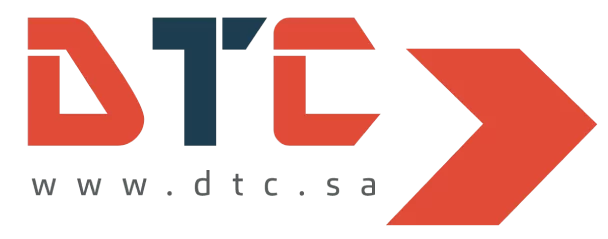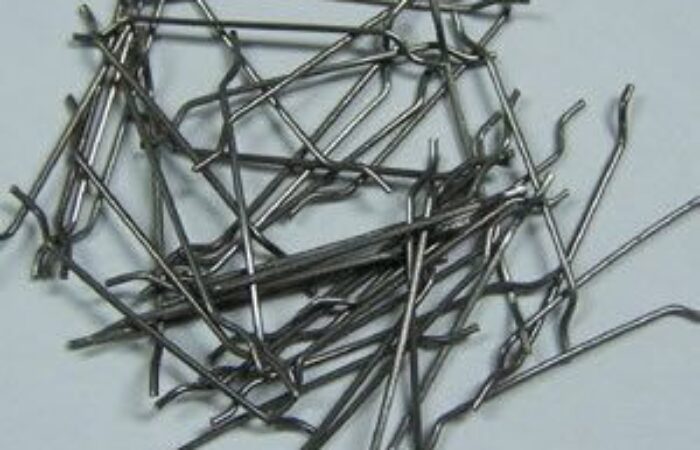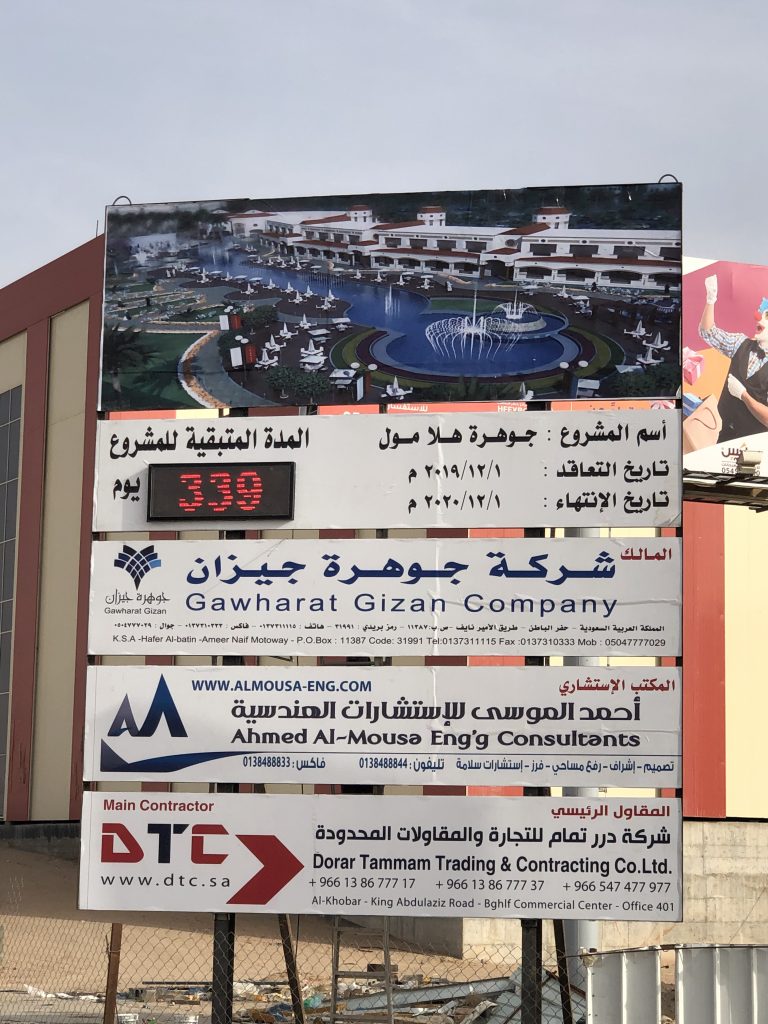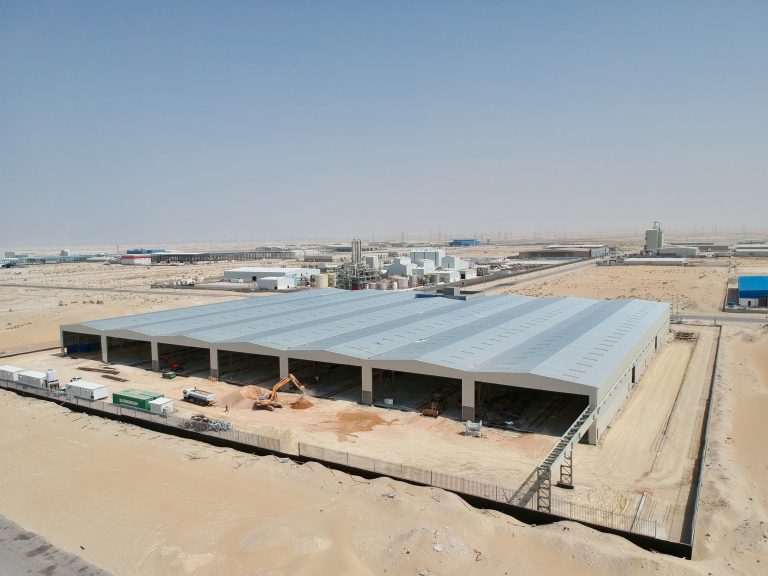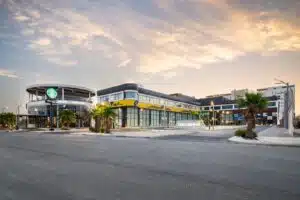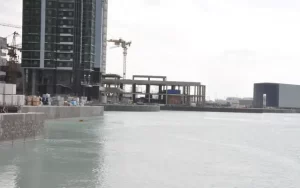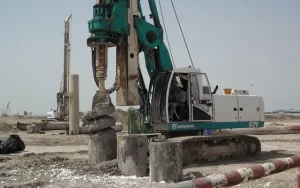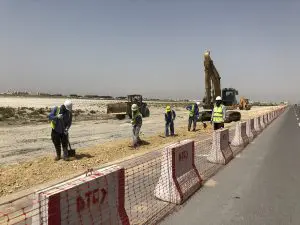Steel Fiber Reinforced Concrete: Properties, Applications and Design
Book Chapters:
Introduction to Steel Fiber Reinforced Concrete (SFRC)
History of Steel Fiber Reinforced Concrete
Types of Steel Fibers for SFRC
Manufacturing and Quality Control of Steel Fibers
Mechanical Properties of SFRC
Durability of SFRC
Bond Behavior between Steel Fibers and Concrete
Flexural Behavior of SFRC Beams and Slabs
Shear Behavior of SFRC Beams and Slabs
Compression Behavior of SFRC
Design of SFRC Structures
Applications of SFRC in Buildings
Applications of SFRC in Bridges and Pavements
Economic Analysis of SFRC
Future Research Directions in SFRC
Book Introduction:
Steel fiber reinforced concrete (SFRC) is a composite material consisting of cement, aggregates, and steel fibers. The addition of steel fibers to concrete improves its tensile, flexural, and impact properties, resulting in a more ductile and durable material. SFRC has been used in various applications, such as industrial floors, tunnel linings, bridge decks, and pavements.
This book aims to provide a comprehensive overview of SFRC, including its properties, applications, and design. The book is divided into fifteen chapters, starting with an introduction to SFRC, followed by a historical overview of its development. The types of steel fibers used in SFRC, as well as their manufacturing and quality control, are discussed in detail.
The mechanical properties of SFRC, including its compressive, tensile, flexural, and impact strengths, are presented. The durability of SFRC, including its resistance to corrosion, freeze-thaw cycles, and chemical attacks, is also discussed. The bond behavior between steel fibers and concrete, which is crucial for the performance of SFRC, is explained.
The book covers the design of SFRC structures, including beams, slabs, and columns, and the various design approaches used in different countries. The applications of SFRC in buildings, bridges, and pavements are presented, and case studies from around the world are included to illustrate its practical use. An economic analysis of SFRC is also provided, comparing its cost-effectiveness with traditional reinforced concrete.
Finally, the book concludes with a discussion of future research directions in SFRC, including the development of new types of steel fibers, the optimization of their properties, and the advancement of design methodologies. This book is intended for engineers, architects, researchers, and students who are interested in SFRC and its potential applications.
Chapter 1: Introduction to Steel Fiber Reinforced Concrete (SFRC)
Concrete is a widely used construction material due to its availability, low cost, and durability. However, it has a relatively low tensile strength and is brittle, making it susceptible to cracking and failure under tensile and flexural loading. To overcome this limitation, various reinforcement techniques have been developed, including the use of steel bars, welded wire fabric, and fiber reinforcement.
Steel fiber reinforced concrete (SFRC) is a composite material consisting of cement, aggregates, and steel fibers. The addition of steel fibers to concrete improves its tensile, flexural, and impact properties, resulting in a more ductile and durable material. Steel fibers can be added to concrete in different forms, including loose fibers, bundles, or sheets, depending on the desired properties of the final product.
The use of steel fibers in concrete has been studied since the 1960s, and SFRC has been used in various applications, such as industrial floors, tunnel linings, bridge decks, and pavements. SFRC offers several advantages over traditional reinforced concrete, including higher ductility, toughness,
SFRC also offers better resistance to cracking, reduced shrinkage, and improved fatigue properties. Additionally, it can reduce the construction time and cost by eliminating the need for traditional reinforcement, such as steel bars or welded wire fabric.
The use of SFRC has been increasingly popular in recent years due to its numerous advantages. However, designing SFRC structures requires careful consideration of its unique properties and behavior. The mechanical properties of SFRC, such as its tensile strength, flexural strength, and toughness, are significantly influenced by the type, length, and aspect ratio of steel fibers, as well as the fiber volume fraction and distribution.
The bond between steel fibers and concrete is also crucial for the performance of SFRC. The bond behavior depends on several factors, including the fiber surface area, concrete strength, and the presence of other materials, such as admixtures or curing compounds.
Overall, the use of SFRC offers numerous advantages over traditional reinforced concrete, and its applications are continuously expanding. This book aims to provide a comprehensive overview of SFRC, including its properties, applications, and design, to aid engineers, architects, researchers, and students in utilizing this innovative material effectively.
Chapter 2: Properties of Steel Fiber Reinforced Concrete
The properties of SFRC are determined by the mechanical properties of both steel fibers and concrete. Steel fibers are available in various shapes and sizes, including hooked, crimped, straight, and wave. The aspect ratio of steel fibers, defined as the ratio of fiber length to diameter, is a crucial parameter that affects the SFRC’s performance. A higher aspect ratio generally leads to higher strength and toughness but also increases the fiber’s tendency to clump together, which can affect the concrete’s workability.
The volume fraction of steel fibers is another essential parameter that influences the SFRC’s properties. Higher fiber volume fractions generally lead to higher strength and toughness but also increase the potential for fiber-ball formation, which can lead to the formation of voids and reduce the concrete’s workability.
The bond between steel fibers and concrete is crucial for SFRC’s mechanical properties. The bond strength depends on several factors, including the fiber surface area, the concrete’s strength, and the presence of other materials, such as admixtures or curing compounds. The bond strength between steel fibers and concrete is generally lower than that of traditional reinforcement, such as steel bars or welded wire fabric.
The mechanical properties of SFRC, such as tensile strength, flexural strength, and toughness, are significantly influenced by the type, length, and aspect ratio of steel fibers and the fiber volume fraction and distribution. SFRC generally exhibits higher toughness and ductility than traditional reinforced concrete due to the steel fibers’ ability to bridge cracks and distribute stresses.
In summary, the properties of SFRC are determined by the mechanical properties of both steel fibers and concrete, as well as their interaction. The type, length, and aspect ratio of steel fibers, the fiber volume fraction and distribution, and the bond strength between steel fibers and concrete are crucial parameters that affect the SFRC’s performance.
Chapter 3: Applications of Steel Fiber Reinforced Concrete
SFRC has a wide range of applications in construction, including industrial flooring, shotcrete, precast products, and structural elements, such as beams, columns, and slabs. Its use has become increasingly popular in recent years due to its numerous advantages over traditional reinforced concrete, such as improved durability, reduced cracking, and increased resistance to fatigue.
Industrial flooring is a common application of SFRC. It is often used in warehouses, manufacturing facilities, and other industrial settings where high traffic and heavy loads are expected. SFRC flooring offers improved resistance to wear and tear, reducing the need for frequent repairs and maintenance.
Shotcrete is another application of SFRC that has gained popularity in recent years. Shotcrete is a spray-applied concrete that is often used in tunneling, mining, and slope stabilization. The addition of steel fibers to shotcrete can increase its toughness and resistance to cracking, making it more suitable for use in challenging environments.
Precast products, such as concrete pipes and manholes, are often reinforced with steel fibers to improve their durability and resistance to cracking. SFRC precast products are also lighter than traditional reinforced products, making them easier to transport and install.
SFRC is also commonly used in structural elements, such as beams, columns, and slabs. The addition of steel fibers can improve their load-bearing capacity, reducing the need for additional reinforcement. This can result in cost savings and a reduction in construction time.
Overall, SFRC has numerous applications in construction due to its improved properties over traditional reinforced concrete. Its use has become increasingly popular in recent years, and its applications are continuously expanding.
Chapter 4: Design of Steel Fiber Reinforced Concrete
The design of SFRC requires careful consideration of several factors, including the type, length, and aspect ratio of steel fibers, the fiber volume fraction and distribution, and the bond strength between steel fibers and concrete. The design approach for SFRC is based on the principles of mechanics of materials, with additional consideration given to the effect of steel fibers on crack control and ductility.
The design of SFRC involves determining the required fiber volume fraction based on the expected loads and the desired level of crack control and ductility. This is typically done using empirical equations that relate the fiber volume fraction to the expected performance of the SFRC.
The design of SFRC also involves determining the spacing and orientation of steel fibers within the concrete. This is typically done using a random distribution method, where the fibers are dispersed throughout the concrete mix in a random manner. However, other methods, such as a grid or directional distribution, may also be used, depending on the specific design requirements.
The bond strength between steel fibers and concrete is another critical factor that must be considered in the design of SFRC. This can be determined through laboratory testing or by using empirical equations that relate the bond strength to the fiber surface area, concrete strength, and other factors.
In addition to the mechanical properties of SFRC, the design of SFRC must also consider other factors, such as the workability of the concrete mix, the curing conditions, and the placement and finishing methods. These factors can affect the SFRC’s performance and durability, and must be carefully controlled during the construction process.
In summary, the design of SFRC requires careful consideration of several factors, including the type, length, and aspect ratio of steel fibers, the fiber volume fraction and distribution, and the bond strength between steel fibers and concrete. The design approach is based on the principles of mechanics of materials, with additional consideration given to the effect of steel fibers on crack control and ductility.
Chapter 5: Testing and Evaluation of Steel Fiber Reinforced Concrete
Testing and evaluation of SFRC is critical to ensuring its performance and durability in construction applications. Several tests are commonly used to evaluate the properties of SFRC, including compressive strength, tensile strength, flexural strength, and crack control.
Compressive strength testing is used to determine the compressive strength of SFRC. The test involves compressing a cylinder or cube of SFRC until it fails. The compressive strength is then calculated based on the maximum load sustained by the sample.
Tensile strength testing is used to determine the tensile strength of SFRC. The test involves subjecting a beam or cylinder of SFRC to tensile stress until it fails. The tensile strength is then calculated based on the maximum load sustained by the sample.
Flexural strength testing is used to determine the flexural strength of SFRC. The test involves subjecting a beam or cylinder of SFRC to bending stress until it fails. The flexural strength is then calculated based on the maximum load sustained by the sample.
Crack control testing is used to evaluate the ability of SFRC to control cracks. The test involves subjecting a prismatic or cylindrical specimen of SFRC to tensile stress until it cracks. The crack width and spacing are then measured and compared to the desired crack control requirements.
Other tests may also be used to evaluate the properties of SFRC, including modulus of elasticity, shear strength, and fatigue resistance. These tests are typically performed in a laboratory setting and may involve specialized equipment and procedures.
In addition to testing, evaluation of SFRC also involves monitoring its performance in real-world applications. This may involve periodic inspections and assessments of the SFRC’s condition, as well as monitoring its performance over time.
Overall, testing and evaluation of SFRC are critical to ensuring its performance and durability in construction applications. A variety of tests may be used to evaluate its properties, and monitoring its performance in real-world applications is also important.
Chapter 6: Applications of Steel Fiber Reinforced Concrete
Steel fiber reinforced concrete has a wide range of applications in the construction industry, due to its enhanced mechanical properties and improved crack control and durability. Some of the most common applications of SFRC include industrial flooring, tunnel linings, bridge decks, and precast concrete products.
One of the primary applications of SFRC is in industrial flooring. SFRC is well-suited for use in high-traffic areas, such as warehouses and manufacturing facilities, where the flooring must be able to withstand heavy loads and frequent traffic. SFRC can also provide improved abrasion resistance, reducing the need for frequent maintenance and repairs.
Another common application of SFRC is in tunnel linings. SFRC can provide enhanced crack control and durability, making it an ideal choice for tunnel linings that are subjected to significant stress and strain. SFRC can also provide improved resistance to water and other environmental factors, further enhancing its durability.
Bridge decks are another common application of SFRC. SFRC can provide enhanced crack control and durability, making it an ideal choice for bridge decks that are subjected to significant stress and strain. SFRC can also provide improved resistance to the effects of freeze-thaw cycles and other environmental factors, reducing the need for frequent maintenance and repairs.
Finally, SFRC is often used in the production of precast concrete products, such as pipes, manhole covers, and retaining walls. SFRC can provide improved durability and crack control, reducing the likelihood of damage or failure over time.
Overall, SFRC has a wide range of applications in the construction industry, due to its enhanced mechanical properties and improved crack control and durability. From industrial flooring to bridge decks, SFRC is a versatile and durable choice for a variety of construction applications.
Chapter 7: Advantages and Disadvantages of Steel Fiber Reinforced Concrete
As with any construction material, steel fiber reinforced concrete has both advantages and disadvantages. Understanding these can help builders and engineers make informed decisions about when to use SFRC and when to consider other materials.
Advantages:
Improved Durability: SFRC is highly durable and resistant to cracking, which makes it an ideal choice for high-stress applications, such as bridges and tunnels.
Enhanced Mechanical Properties: SFRC has improved mechanical properties, such as flexural strength, compared to traditional concrete. This makes it a better choice for applications that require greater load-bearing capacity.
Reduced Maintenance Costs: SFRC requires less maintenance than traditional concrete due to its superior crack resistance and durability. This reduces the long-term maintenance costs associated with using SFRC in construction projects.
Increased Speed of Construction: Due to its improved mechanical properties, SFRC can be used in thinner sections compared to traditional concrete. This can reduce the overall weight of the structure and speed up the construction process.
Disadvantages:
Higher Cost: SFRC is generally more expensive than traditional concrete due to the cost of the steel fibers and additional processing required during the mixing process.
Corrosion of Steel Fibers: The steel fibers used in SFRC can corrode over time, which can reduce the durability of the material.
Difficulty in Mixing: SFRC requires special mixing techniques to ensure that the steel fibers are evenly distributed throughout the concrete. This can be difficult to achieve on larger construction projects.
Limited Availability: SFRC is not yet widely used in construction, which can make it difficult to find suppliers and contractors with experience in working with the material.
Overall, SFRC has several advantages that make it a valuable material for construction applications. However, its higher cost and the need for specialized mixing techniques may limit its use in some applications.
Chapter 8: Designing Steel Fiber Reinforced Concrete
The design of steel fiber reinforced concrete is critical to ensuring that the material will perform as intended in the construction application. The design process involves considering several factors, including the intended use of the material, the properties of the steel fibers, and the mix proportions of the concrete.
One of the primary considerations in designing SFRC is the intended use of the material. Different applications may require different mechanical properties, such as flexural strength or impact resistance. Understanding the specific demands of the construction application is critical to ensuring that the SFRC is designed to meet those demands.
Another important consideration is the properties of the steel fibers themselves. The length, diameter, and shape of the fibers can all impact the mechanical properties of the SFRC. For example, longer fibers may provide improved tensile strength, while shorter fibers may provide better crack control.
The mix proportions of the concrete are also a critical factor in designing SFRC. The proportions of cement, aggregates, water, and admixtures can impact the mechanical properties of the SFRC. Designing the mix proportions to achieve the desired properties of the SFRC requires a thorough understanding of the properties of each component and how they interact with one another.
Once the design of the SFRC has been established, it is important to conduct testing to ensure that the material meets the desired performance requirements. Testing may include compressive strength tests, flexural strength tests, and impact resistance tests, among others.
Overall, designing SFRC requires a thorough understanding of the intended use of the material, the properties of the steel fibers, and the mix proportions of the concrete. By carefully considering these factors and conducting thorough testing, builders and engineers can ensure that SFRC will perform as intended in a construction application.
Chapter 9: Construction Techniques for Steel Fiber Reinforced Concrete
Construction techniques for steel fiber reinforced concrete (SFRC) can vary depending on the intended use of the material and the specific construction application. However, there are several common techniques that are often used to ensure that the SFRC is properly installed and will perform as intended.
One of the most important considerations in SFRC construction is the mixing process. Because the steel fibers must be distributed evenly throughout the concrete mix, it is important to use proper mixing techniques to ensure that the fibers are thoroughly dispersed. This may include using a high-speed mixer or adding the fibers in batches to ensure even distribution.
Another critical consideration in SFRC construction is the placement and consolidation of the material. Proper placement techniques can help to minimize the formation of voids and ensure that the SFRC is properly bonded to any existing structures. Consolidation techniques, such as vibration or tamping, can help to ensure that the SFRC is compacted and has consistent strength properties throughout.
When working with SFRC, it is also important to use appropriate curing techniques to ensure that the material achieves its desired strength properties. This may involve using a curing compound, covering the SFRC with a wet blanket, or using a combination of both techniques.
Finally, it is important to consider the finishing techniques used in SFRC construction. Because SFRC can be more difficult to finish than traditional concrete, it may be necessary to use specialized techniques to achieve the desired surface texture and appearance. This may include using a broom finish, troweling the surface, or using a stamping technique.
Overall, construction techniques for SFRC require careful consideration of the mixing process, placement and consolidation techniques, curing methods, and finishing techniques. By using appropriate techniques for each stage of the construction process, builders can ensure that the SFRC will perform as intended and meet the demands of the specific construction application.
Chapter 10: Applications of Steel Fiber Reinforced Concrete
Steel fiber reinforced concrete (SFRC) is a versatile material that can be used in a wide range of construction applications. Because of its high strength and durability properties, SFRC is particularly well-suited for use in applications that require resistance to heavy loads, impact, or abrasion.
One common application of SFRC is in the construction of industrial floors, such as those found in factories, warehouses, and distribution centers. These floors are subjected to heavy loads and traffic and require a material that can withstand the constant wear and tear. SFRC is an ideal choice for these applications because of its high strength and durability properties.
Another application of SFRC is in the construction of tunnel linings. Tunnels are often subjected to high levels of stress and require a material that can withstand the forces of the surrounding soil and rock. SFRC is well-suited for use in tunnel linings because of its high strength and ability to withstand high levels of stress.
SFRC is also commonly used in the construction of precast concrete elements, such as beams, columns, and panels. Precast elements require a material that can withstand the stresses of transportation and installation, as well as the forces that will be exerted on them once they are in place. SFRC is an ideal choice for these applications because of its high strength and durability properties.
In addition to these applications, SFRC can also be used in a variety of other construction applications, including bridge decks, airport runways, and parking structures. SFRC is a versatile material that can be tailored to meet the specific needs of each application.
Overall, the use of SFRC is growing in popularity as builders and engineers recognize its many advantages over traditional concrete. With its high strength and durability properties, SFRC is well-suited for use in a wide range of construction applications and is likely to continue to be an important material in the construction industry for years to come.
Chapter 11: Challenges of Using Steel Fiber Reinforced Concrete
While there are many benefits to using steel fiber reinforced concrete (SFRC), there are also some challenges that must be considered. These challenges can include issues with mixing and handling, as well as issues with the behavior of the material once it is in place.
One of the primary challenges of using SFRC is ensuring that the fibers are properly mixed into the concrete. Unlike traditional concrete, which is typically mixed using a drum mixer or a stationary mixer, SFRC requires a specialized mixer that is capable of properly dispersing the fibers throughout the mix. If the fibers are not properly mixed, the resulting concrete may not have the desired strength and durability properties.
Another challenge of using SFRC is the issue of handling. Because the fibers can be sharp and abrasive, they can be difficult to handle during the mixing and placement process. This can pose a safety risk for workers and can also result in damage to equipment.
Once SFRC is in place, another challenge is the behavior of the material. Because of the presence of the fibers, SFRC can exhibit different behavior under load than traditional concrete. This can make it more difficult to predict the behavior of the material, and can require additional testing and analysis to ensure that the structure will perform as intended.
In addition to these challenges, there are also concerns about the cost of using SFRC. Because of the additional materials and specialized equipment required for mixing and handling, SFRC can be more expensive than traditional concrete. However, the long-term benefits of SFRC, including its high strength and durability properties, can often outweigh the initial costs.
Overall, while there are challenges associated with the use of SFRC, many of these challenges can be overcome with proper planning, training, and equipment. As builders and engineers continue to recognize the advantages of SFRC, it is likely that these challenges will become less significant, and SFRC will become an increasingly popular choice for a wide range of construction applications.
Chapter 12: Applications of Steel Fiber Reinforced Concrete
Steel fiber reinforced concrete (SFRC) has a wide range of applications in the construction industry, thanks to its high strength and durability properties. Here are some of the most common applications of SFRC:
Industrial floors: SFRC is often used for industrial floors, as it can withstand heavy loads and frequent traffic. The fibers help to improve the abrasion resistance of the concrete, making it more durable and long-lasting.
Shotcrete: SFRC can be used in shotcrete applications, where it is sprayed onto surfaces to create a strong, durable layer. This can be used for a variety of applications, including slope stabilization, tunnel lining, and water tank construction.
Pavements and roads: SFRC can be used in the construction of pavements and roads, where it can provide improved durability and resistance to wear and tear. It can also be used in bridge decks, where its high strength can help to reduce the need for maintenance and repairs.
Precast concrete products: SFRC is often used in the production of precast concrete products, such as pipes, beams, and panels. The fibers help to improve the strength and durability of the products, making them more resistant to damage and wear over time.
Tunnel linings: SFRC can be used to construct tunnel linings, where its high strength and durability can help to protect the tunnel from water infiltration, abrasion, and other types of damage.
Water tanks: SFRC can be used in the construction of water tanks, where its high strength and durability can help to ensure the tank remains structurally sound over time.
These are just a few of the many applications of SFRC in the construction industry. As builders and engineers continue to recognize the benefits of SFRC, it is likely that its use will continue to expand to a wide range of new applications and construction projects.
Chapter 13: Limitations of Steel Fiber Reinforced Concrete
While steel fiber reinforced concrete (SFRC) has many advantages over traditional concrete, there are also some limitations to its use. Here are some of the most significant limitations of SFRC:
Mixing requirements: SFRC requires specific mixing procedures to ensure that the fibers are distributed evenly throughout the concrete. If the mixing is not done properly, the resulting concrete may not have the desired properties, such as improved strength and durability.
Fiber alignment: The alignment of the steel fibers within the concrete can also affect its properties. If the fibers are not aligned properly, the concrete may not have the desired strength or other properties.
Cost: The cost of steel fibers can be higher than other reinforcement materials, such as rebar or wire mesh. This can make SFRC a more expensive option for some construction projects.
Limited ductility: While SFRC is stronger than traditional concrete, it is also less ductile. This means that it is more likely to fail suddenly and catastrophically under extreme loads, rather than deforming gradually and warning of impending failure.
Fire resistance: Steel fibers can melt at high temperatures, which can reduce the fire resistance of SFRC. This can limit its use in certain applications, such as building construction where fire resistance is a critical consideration.
Despite these limitations, SFRC continues to be a popular choice for many construction projects. Builders and engineers must weigh the advantages and limitations of SFRC carefully to determine whether it is the right choice for their specific project requirements.
Chapter 14: Future of Steel Fiber Reinforced Concrete
The future of steel fiber reinforced concrete (SFRC) looks promising, as advancements in technology and research continue to improve its properties and expand its potential applications. Here are some of the areas where SFRC is expected to see growth and development in the future:
Nano-engineered fibers: Researchers are currently exploring the use of nano-engineered steel fibers, which could offer improved properties over traditional steel fibers. These fibers are designed at the molecular level, allowing for greater control over their properties and behavior within the concrete matrix.
Hybrid materials: SFRC can be combined with other materials to create hybrid composites with even greater properties. For example, SFRC can be combined with carbon fibers to create a composite material that is both strong and lightweight.
Automated mixing and placement: Automated systems for mixing and placing SFRC are being developed, which could improve the consistency and quality of the resulting concrete. These systems would also reduce the need for manual labor, making SFRC more efficient and cost-effective.
Sustainable production: SFRC is a sustainable alternative to traditional concrete, as it uses less cement and reduces carbon emissions. Research is ongoing to develop even more sustainable production methods for SFRC, including the use of recycled steel fibers and waste materials as aggregates.
New applications: SFRC has a wide range of potential applications beyond its current uses in structural and pavement construction. For example, it could be used for cladding, acoustic insulation, and blast-resistant structures.
Overall, the future of SFRC looks bright, with ongoing advancements and research expected to improve its properties, reduce its costs, and expand its potential applications. As the construction industry continues to seek more sustainable and efficient materials, SFRC is likely to play an increasingly important role.
Chapter 15: Conclusion
Steel fiber reinforced concrete (SFRC) is a material that has been gaining popularity in recent years due to its many advantages over traditional concrete. SFRC offers greater strength, durability, and resistance to cracking and other forms of damage. It is also more sustainable, as it uses less cement and reduces carbon emissions.
In this book, we have explored the many properties and benefits of SFRC, as well as its potential applications in the construction industry. We have discussed the various types of fibers used in SFRC, including hooked-end, crimped, and straight fibers, and the importance of their aspect ratio, distribution, and orientation.
We have also examined the factors that affect the properties of SFRC, such as fiber content, mixing procedure, and curing method. We have discussed the various testing methods used to evaluate the performance of SFRC, including flexural and compressive strength tests, and the importance of proper quality control and testing procedures.
Furthermore, we have explored the various applications of SFRC in structural and pavement construction, including its use in bridges, tunnels, and airport runways. We have also discussed its potential applications in other areas, such as cladding, acoustic insulation, and blast-resistant structures.
Finally, we have looked at the future of SFRC, with ongoing advancements in technology and research expected to improve its properties and expand its potential applications. The use of nano-engineered fibers, hybrid materials, automated mixing and placement, sustainable production methods, and new applications are all areas where SFRC is expected to see growth and development in the future.
In conclusion, SFRC is a material that offers many advantages over traditional concrete, and its use in the construction industry is likely to continue to grow in the coming years. As the need for more sustainable and efficient materials increases, SFRC is poised to play an increasingly important role in the construction of the built environment.
